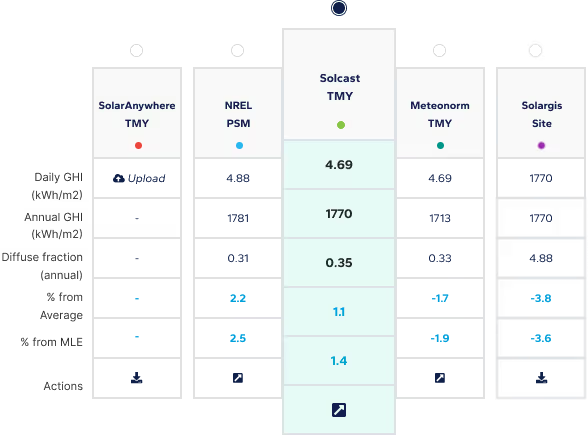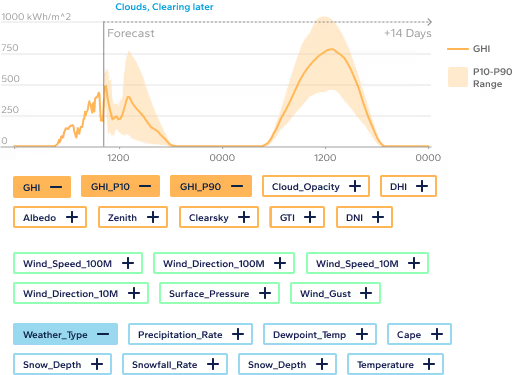Typical Meteorological Year
Download a statistically representative “typical year” file built from 15 + years of satellite data for long-term yield modelling.
IRRADIANCE , WIND AND WEATHER DATA
Power Forecasting Models
Insights
Validations
IRRADIANCE AND WEATHER DATA
Historical Time Series
Typical Meteorological Year
Live Data
Forecast Data
POWER FORECASTING MODELS
DNV GREEN DATA PRODUCTS
Solcast is independently validated as the lowest uncertainty solar resource dataset

SolarAnywhere is a long-running commercial source of satellite-derived irradiance data, with a regional focus on North America. SolarAnywhere’s more expensive 1km data over North America is generally considered bankable by the industry. However, amongst commercial providers, SolarAnywhere is the least extensively and least independently validated data source. Compared with SolarAnywhere, Solcast has lower uncertainty, more validation, is faster to access, and is generally cheaper and easier to use.
SolarAnywhere is a data offering by US company Clean Power Research. The company focuses on a wide range of services and software related to electricity and utilities, with a particular focus on California and the United States.
SolarAnywhere and Solcast are both sources of global historical data and TMY. Solcast is considered globally bankable, whereas SolarAnywhere’s bankability is limited to its 1km dataset in North America. Solcast tends to be lower cost (except for SolarAnywhere’s degraded 10km offering), and is free to test all products with instant access, compared to SolarAnywhere where testing is more limited and not instant.
Solcast | SolarAnywhere | |
|---|---|---|
Free trial with instant access and data download? | | |
Download wait time | 1-3 seconds | 5 minutes |
Comprehensive, global, independent validation | | |
Finest time resolution of satellite-based irradiance | 5 minutes | 5 minutes |
Real time data available? | | |
| |
Meta analysis of large global validation studies: GHI results | ||
|---|---|---|
Solcast | SolarAnywhere | |
Performed by | DNV | SolarAnywhere |
Year published | 2023 | 2023 |
No. of sites | 207 | 53 |
Mean Bias | +0.33% | +0.01% |
Bias Std. Dev. | ±2.47% | ±2.13% |
80% CI Bias (10% to 90%) | -2.84% to 3.50% | Not Published |
90% CI Bias (5% to 95%) | -3.74% to 4.40% | Not Published |
Mean nMAD (nMAE) | 10.33% | 12.20% |
Std. Dev. nMAD (nMAE) | ±3.72% | Not Published |
Mean nRMSD (nRMSE) | 15.99% | 20.60% |
Std. Dev. nRMSD (nRMSE) | ±5.74% | Not Published |
The SolarAnywhere and Solcast methodology is relatively similar. Both are semi-empirical and are satellite-derived. Both rely on validated, published models to build a clear sky model, and use proprietary cloud detection models. The input satellite imagery is similar, with SolarAnywhere using approx. 1-10km grids and Solcast using approx. 1-2km grids. Solcast's irradiance data and PV power data is then downscaled to 90 metres. The SolarAnywhere database is compiled using high-resolution new satellites, and lower-resolution, pre-21st century satellites. Data coverage begins in 1998. Solcast only uses data from recent generation geostationary meteorological satellites (GMS). We do not use data prior to 2007 due to climate change and satellite data quality issues . This maximises data quality and validity, while still providing 15+ years of data history from which to sample for interannual variability.
SolarAnywhere and Solcast are very different in terms of validation. Solcast has 200+site global and independent validation, while SolarAnywhere has only 54 site non-independent validation (which is focused on American sites that have been repeatedly used for model calibration). The SolarAnywhere validation is not sufficient to accurately measure its uncertainty in terms of bias spread. Even on the available information, Solcast is more accurate and has lower uncertainty than SolarAnywhere data. Compared to SolarAnywhere, Solcast has lower hourly RMSE, less bias in DNI, and about the same (near zero) bias in GHI.
A paper published in 2024 by Dr A. F. Almarshoud, available here, assessed the accuracy of SolarAnywhere data in comparison with Solargis and Solcast data across 6 sites in Saudi Arabia. The study concluded "the values predicted by the SUNY (SolarAnywhere) model are less accurate than those predicted by Solargis and Solcast models for both GHI and DNI."
Meta analysis of large global validation studies: DNI results | ||
|---|---|---|
Solcast | SolarAnywhere | |
Performed by | DNV | SolarAnywhere |
Year published | 2023 | 2023 |
No. of sites | 117 | 45 |
Mean Bias | +1.50% | +3.0% |
Bias Std. Dev. | ±5.75% | ±6.2% |
80% CI Bias (10% to 90%) | -5.87% to 8.86% | Not Published |
90% CI Bias (5% to 95%) | -7.96% to 10.95% | Not Published |
Mean nMAD (nMAE) | 19.97% | Not Published |
Std. Dev. nMAD (nMAE) | ±5.94% | Not Published |
Mean nRMSD (nRMSE) | 31.51% | Not Published |
Std. Dev. nRMSD (nRMSE) | ±9.99% | Not Published |


Download a statistically representative “typical year” file built from 15 + years of satellite data for long-term yield modelling.


Compare multiple satellite data sets side-by-side to choose the most bankable resource file for your site.


Access industry-leading solar forecasts up to 14 days ahead, combining satellite nowcasting and weather models for precision energy planning.
Subscribe to our newsletter to keep up to date with all the latest news.

Subscribe to our newsletter to keep up to date with all the latest news.